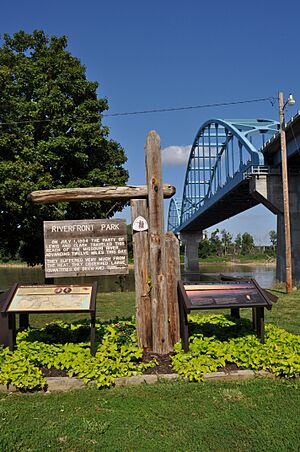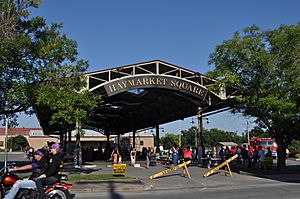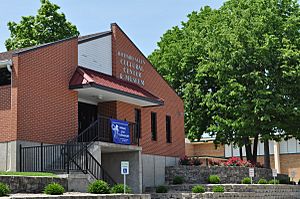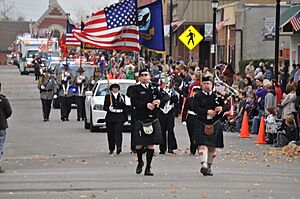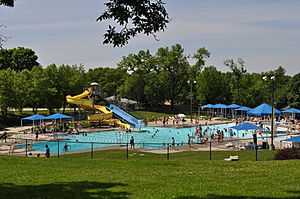Leavenworth, Kansas facts for kids
Quick facts for kids
Leavenworth, Kansas
|
||
|---|---|---|
|
City and County seat
|
||
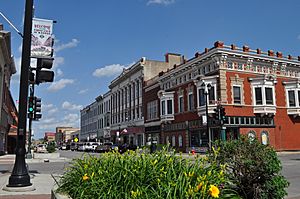
Downtown Leavenworth (2014)
|
||
|
||
| Motto(s):
First City of Kansas
|
||
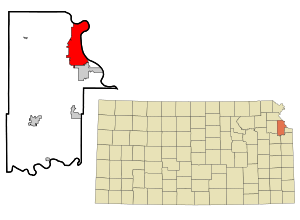
Location within Leavenworth County and Kansas
|
||
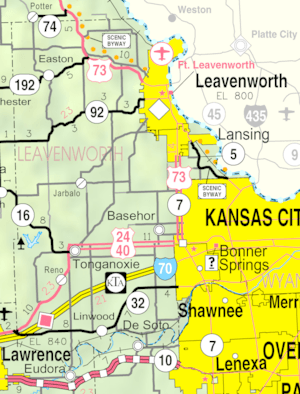
|
||
| Country | United States | |
| State | Kansas | |
| County | Leavenworth | |
| Founded | 1854 | |
| Incorporated | 1855 | |
| Government | ||
| • Type | Commission-Manager | |
| Area | ||
| • Total | 24.31 sq mi (62.95 km2) | |
| • Land | 24.24 sq mi (62.79 km2) | |
| • Water | 0.06 sq mi (0.16 km2) | |
| Elevation | 840 ft (260 m) | |
| Population
(2020)
|
||
| • Total | 37,351 | |
| • Density | 1,536.4/sq mi (593.34/km2) | |
| Time zone | UTC-6 (CST) | |
| • Summer (DST) | UTC-5 (CDT) | |
| ZIP codes |
66043, 66048
|
|
| Area code | 913 | |
| GNIS ID | 485610 | |
Leavenworth is a city in Kansas, United States. It is the biggest city in Leavenworth County and its main town. The city is part of the larger Kansas City metropolitan area. In 2020, about 37,351 people lived here.
Leavenworth is located on the west side of the Missouri River. It is famous for Fort Leavenworth, which was built in 1827. The city was an important supply base for people moving west in American history. During the American Civil War, many people from Leavenworth joined the Union Army. The city is also known for its prisons, like the United States Disciplinary Barracks and United States Penitentiary, Leavenworth.
Contents
History of Leavenworth
Leavenworth was started in 1854. It was the very first city to become an official city in the Kansas territory. The city grew just south of Fort Leavenworth. This fort was first set up in 1827 by Colonel Henry Leavenworth.
Because it was on the Missouri River, Leavenworth became a safe place. Many African Americans who were enslaved in Missouri came here seeking freedom. People who were against slavery helped them find safety. Before the American Civil War, Leavenworth was a place where people strongly argued about slavery. These arguments sometimes even led to fights in the streets.
On April 3, 1858, a special document called the "Leavenworth Constitution" was created in the city. This document was a plan for Kansas to become a state. It was very important because it said that freed Black people should be citizens. Even though the government never fully approved this plan, it showed how forward-thinking Leavenworth was.
During the Civil War, more African Americans moved to Leavenworth. By 1865, almost one-fifth of all Black people in Kansas lived there. Charles Henry Langston was a key African-American leader in Leavenworth after the war. He worked hard for Black people to have the right to vote, serve on juries, and send their children to public schools. Black Americans gained the right to vote in 1870. They also got the right to be on juries in 1874.
Many African Americans kept moving to Kansas after the war. Most of them lived in cities like Leavenworth. Fort Leavenworth was outside the city limits for a long time. But in 1977, it officially became part of the city. In 2008, old underground "vaults" were discovered in the city. They were likely built in the late 1800s.
Geography and Climate
Leavenworth is in northeastern Kansas. It sits where two main roads, U.S. Route 73 and Kansas Highway 92, meet. The city is about 25 miles (40 km) northwest of downtown Kansas City.
The city is on the west side of the Missouri River. This area is known for its rolling hills and plains. Four small streams flow through the city into the river. These are Quarry Creek, Corral Creek, Three Mile Creek, and Five Mile Creek.
Leavenworth covers about 24 square miles (62 square kilometers). Most of this area is land. Fort Leavenworth takes up the northern half of the city's land. Leavenworth is part of the larger Kansas City metropolitan area. The city of Lansing, Kansas is located just south of Leavenworth.
Leavenworth's Climate
Leavenworth has a mix of two types of weather. It has hot, humid summers and cold, drier winters. This is called a "transition zone" climate.
- Temperatures: The average temperature in Leavenworth is 55°F (13°C). January is usually the coldest month, with lows around 19°F (-7°C). July is the hottest, with highs around 90°F (32°C). Temperatures can reach 90°F (32°C) about 43 days a year. They can even go above 100°F (38°C) about four days a year. The temperature drops below freezing (32°F or 0°C) about 107 days a year. The hottest temperature ever recorded was 110°F (43°C) in 1954. The coldest was -27°F (-33°C) in 1989.
- Rain and Snow: Leavenworth gets about 43 inches (109 cm) of rain each year. It rains or snows on about 90 days a year. The city also gets about 16 inches (41 cm) of snow annually. Snow falls on about eight days a year.
- Storms: Strong thunderstorms can happen, especially in the spring. These storms can bring strong winds and large hail. There is also a risk of tornadoes during these storms.
| Climate data for Leavenworth, Kansas | |||||||||||||
|---|---|---|---|---|---|---|---|---|---|---|---|---|---|
| Month | Jan | Feb | Mar | Apr | May | Jun | Jul | Aug | Sep | Oct | Nov | Dec | Year |
| Record high °F (°C) | 74 (23) |
81 (27) |
87 (31) |
93 (34) |
97 (36) |
106 (41) |
110 (43) |
108 (42) |
104 (40) |
95 (35) |
84 (29) |
70 (21) |
110 (43) |
| Mean daily maximum °F (°C) | 39 (4) |
45 (7) |
56 (13) |
67 (19) |
76 (24) |
85 (29) |
90 (32) |
88 (31) |
80 (27) |
68 (20) |
54 (12) |
41 (5) |
66 (19) |
| Daily mean °F (°C) | 30 (−1) |
35 (2) |
45 (7) |
55 (13) |
65 (18) |
74 (23) |
79 (26) |
78 (26) |
68 (20) |
57 (14) |
44 (7) |
32 (0) |
55 (13) |
| Mean daily minimum °F (°C) | 19 (−7) |
24 (−4) |
33 (1) |
43 (6) |
54 (12) |
63 (17) |
69 (21) |
67 (19) |
57 (14) |
46 (8) |
33 (1) |
23 (−5) |
44 (7) |
| Record low °F (°C) | −17 (−27) |
−19 (−28) |
−10 (−23) |
4 (−16) |
27 (−3) |
42 (6) |
45 (7) |
41 (5) |
30 (−1) |
18 (−8) |
−2 (−19) |
−27 (−33) |
−27 (−33) |
| Average precipitation inches (mm) | 1.03 (26) |
1.53 (39) |
2.74 (70) |
4.04 (103) |
5.38 (137) |
5.92 (150) |
5.20 (132) |
4.49 (114) |
4.82 (122) |
3.78 (96) |
2.45 (62) |
1.59 (40) |
42.97 (1,091) |
| Average snowfall inches (cm) | 4.4 (11) |
5.3 (13) |
1.7 (4.3) |
0 (0) |
0 (0) |
0 (0) |
0 (0) |
0 (0) |
0 (0) |
0.2 (0.51) |
0.7 (1.8) |
3.8 (9.7) |
16.1 (40.31) |
| Average precipitation days (≥ 0.01 in) | 4.7 | 5.1 | 7.9 | 8.9 | 11.2 | 9.9 | 7.5 | 8.0 | 7.6 | 7.3 | 6.4 | 5.2 | 89.7 |
| Average snowy days (≥ 0.1 in) | 2.3 | 2.3 | 0.8 | 0 | 0 | 0 | 0 | 0 | 0 | 0 | 0.4 | 2.1 | 7.9 |
| Source: National Weather Service; The Weather Channel | |||||||||||||
People of Leavenworth
| Historical population | |||
|---|---|---|---|
| Census | Pop. | %± | |
| 1860 | 7,429 | — | |
| 1870 | 17,873 | 140.6% | |
| 1880 | 16,546 | −7.4% | |
| 1890 | 19,768 | 19.5% | |
| 1900 | 20,735 | 4.9% | |
| 1910 | 19,363 | −6.6% | |
| 1920 | 16,912 | −12.7% | |
| 1930 | 17,466 | 3.3% | |
| 1940 | 19,220 | 10.0% | |
| 1950 | 20,579 | 7.1% | |
| 1960 | 22,052 | 7.2% | |
| 1970 | 25,147 | 14.0% | |
| 1980 | 33,656 | 33.8% | |
| 1990 | 38,495 | 14.4% | |
| 2000 | 35,420 | −8.0% | |
| 2010 | 35,251 | −0.5% | |
| 2020 | 37,351 | 6.0% | |
| U.S. Decennial Census 2010-2020 |
|||
Leavenworth is the 10th largest city in the Kansas City metropolitan area by population.
Population Facts
In 2020, there were 37,351 people living in Leavenworth. The city has many different kinds of people. Most residents are white, but there are also many Black, Native American, Asian, and Hispanic or Latino people. Many people also identify with two or more races. This mix of cultures makes Leavenworth a diverse place.
About a quarter of the people in Leavenworth are under 18 years old. The average age in the city is about 35 years old.
Religious Life
Leavenworth has many different churches and religious groups. This is partly because of its long history and the many military families who have lived there. In the past, Leavenworth had one of the biggest Jewish communities in Kansas.
Today, you can find many types of Christian churches, including United Methodist, Lutheran, Episcopal, and Catholic churches. There is also a Church of Jesus Christ of Latter-day Saints and the Islamic Center of Leavenworth. Some churches even have services in Korean.
Leavenworth is important in the history of the Catholic Church in Kansas. It was once the center of a very large Catholic area. The Cathedral of the Immaculate Conception was built here in 1854.
Leavenworth's Economy
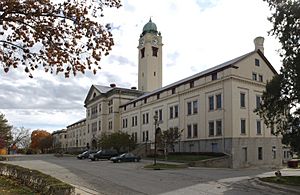
Many people in Leavenworth have jobs. About half of the adults work in civilian jobs, and some work in the armed forces. People work in many different areas, like management, sales, and service jobs.
The biggest employer in Leavenworth is the U.S. military at Fort Leavenworth. It employs about 5,600 people. Other big employers include the local public schools and the Department of Veteran Affairs, which helps military veterans.
The cost of living in Leavenworth is lower than the average for the United States. This means it's generally less expensive to live there.
Main Employers in Leavenworth
Here are some of the biggest employers in Leavenworth:
| # | Employer | # of Employees |
|---|---|---|
| 1 | Fort Leavenworth | 4,185 |
| 2 | U.S.D. 453 (School District) | 996 |
| 3 | Dwight D. Eisenhower Veterans Affairs Medical Center | 700 |
| 4 | Northrop Grumman | 700 |
| 5 | Central Plains Consolidated Accounts | 400 |
| 6 | Cubic Defense Applications Group | 390 |
| 7 | Leavenworth Federal Penitentiary | 380 |
| 8 | Leavenworth County | 352 |
| 9 | Walmart Supercenter | 350 |
| 10 | Hallmark Cards, Inc | 260 |
Arts, Culture, and Fun
Museums to Explore
Leavenworth has several interesting museums:
- The C.W. Parker Carousel Museum is famous for its old carousels. It's even called one of the "8 Wonders of Kansas Customs."
- The Fred Harvey Museum teaches about the Harvey family and their famous "Harvey Houses." These were restaurants and hotels along old train routes.
- The Leavenworth County Historical Society has a museum in the Edward Carroll House. This is a beautiful old mansion you can tour.
- The Richard Allen Cultural Center and Museum shows items from African-American pioneers and soldiers. It has old photos from the 1870s to the 1920s.
Events and Celebrations
- Community Theater: The River City Community Players put on plays and musicals all year long.
- Saint Patrick's Day Parade: Every year on March 17, there's a big parade in downtown Leavenworth. It starts with a special church service. The money raised from events during the day goes to local charities.
Military Connections
Leavenworth holds a parade every year on Veterans Day to honor military veterans. The city has active groups like the American Legion and Veterans of Foreign Wars. Leavenworth High School is special because it has the very first Junior Reserve Officer Training Corps (JROTC) program in the country.
Cool Places to Visit
Leavenworth has a historic shopping area with 28 blocks. You can find antique shops, restaurants, a brewery, and unique gift shops there.
Haymarket Square is a covered area where a local farmer's market is held from May to October.
Parks and Recreation
The Leavenworth Parks and Recreation Department takes care of over 25 public parks. They also manage the Riverfront Community Center. This center has an indoor gym and a swimming pool. The Wollman Aquatic Center is another great place for swimming. There's even a special park for dogs where they can run off-leash. It was built with donations from the public in 2010.
Education in Leavenworth
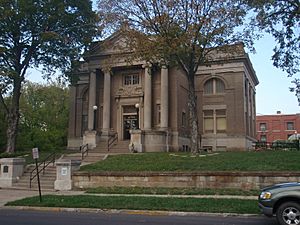
Schools for Kids
Leavenworth has two public school districts. Most of the city is in Leavenworth USD 453. This district has four elementary schools, one middle school, and Leavenworth High School. They also have an online school for younger students. Students from Fort Leavenworth go to Leavenworth High School. The middle school, Richard Warren Middle School, recently added a new technology building.
A smaller part of the city, Fort Leavenworth, has its own school district, Fort Leavenworth USD 207. This district has three elementary schools and one junior high school. Some students in southern Leavenworth go to schools in the Lansing USD 469 district, like Lansing High School.
There are also two private schools in Leavenworth. Xavier Elementary School is a Catholic school for students from Pre-K to 8th grade. St. Paul Lutheran School is a Lutheran school, also for Pre-K to 8th grade.
Colleges and Universities
The main campus of University of Saint Mary is in Leavenworth. This is a four-year, private Catholic university. Kansas City Kansas Community College also has a campus in the city.
Media and News
The Leavenworth Times is the city's daily newspaper. It is published by CherryRoad Media. CherryRoad Media also publishes The Fort Leavenworth Lamp, a weekly newspaper that covers news about the local military base.
Leavenworth is part of the Kansas City radio and television areas. There are two radio stations based in Leavenworth: KKLO (1410 AM) which broadcasts Fox News, and KQRC-FM (98.9 FM) which plays rock music. The main regional newspaper is the Kansas City Star.
Getting Around Leavenworth
In April 2023, a new service called RideLV started in Leavenworth. It's an on-demand transit service, meaning you can use a phone app to ask for a ride when you need it. This service helps people get around the city. Even with this new service, Leavenworth is still the largest city in Kansas without regular bus routes.
Famous People from Leavenworth
Many interesting people have lived or worked in Leavenworth:
- Charles Henry Langston was a political activist who lived here. He helped African-American refugees and worked for equal rights after the Civil War.
- Dwight D. Eisenhower, who later became the 34th President of the United States, once served at Fort Leavenworth.
- Famous figures from the "Old West" like Buffalo Bill Cody and Wild Bill Hickok also lived and worked in Leavenworth.
- Other notable people include rock musician Melissa Etheridge, restaurant founder Fred Harvey, and former NBA player Wayne Anthony Simien.
Sister Cities
Leavenworth has "sister cities" in other countries. These are cities that partner with Leavenworth to share culture and ideas.
Images for kids
See also
 In Spanish: Leavenworth (Kansas) para niños
In Spanish: Leavenworth (Kansas) para niños



